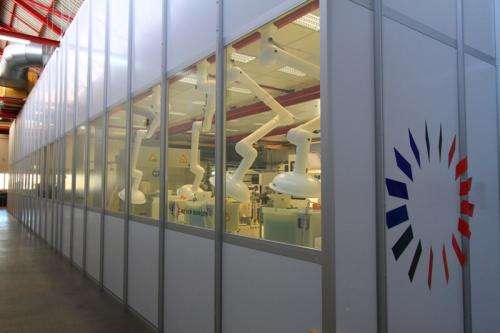Paving the way for the production of high-performance solar cells

Doris Leuthard, a member of the Swiss Federal Council, opened a pilot plant for the production of high efficiency heterojunction (HJT) solar cells at Meyer Burger Research AG in Hauterive, Neuchâtel today. The Swiss solar industry supplier Meyer Burger is aiming to further optimize an innovative cell coating process to industrial manufacturing standards with this pilot plant. The plant was developed together with CSEM and with support from the Swiss Federal Office of Energy and the Canton of Neuchâtel. This process will produce even more efficient solar cells in the future.
High efficiency, high yield and low production costs are the advantages with which the process for producing highly efficient solar cells with heterojunction technology (HJT) will have a major impact on the solar market in the future. The pilot plant was inaugurated today at Meyer Burger Research, a subsidiary of the Meyer Burger Group, in the presence of Swiss Federal Council member Doris Leuthard. The ceremony marked a first major milestone. The pilot production is the heart of the wide-ranging Swiss-Inno HJT project, which is promoted as part of the pilot, demonstrations and flagship program of the Swiss Federal Office of Energy and the Canton of Neuchâtel. Federal Council member Leuthard praised the project: "The production plant inaugurated today is a successful example of the collaboration between advanced research and market-driven development as well as a flagship project for Switzerland's innovative drive in the growing cleantech sector. Thanks to its industrial and scientific expertise, Switzerland is ideally positioned to establish itself in a challenging international arena."
Jean-Nat Karakash, a Neuchâtel State Council member, also welcomed this highly innovative project: "If you forge collaboration with local industry using cutting-edge technologies from research and development institutes, innovative ideas can be quickly implemented into products. Meyer Burger Research, formerly Roth & Rau Research, made the right decision when they chose this region as the location for their research and development center several years ago."
Vast market potential
The Meyer Burger technology group is a leading global equipment provider in the photovoltaic industry. As part of this project, it is striving to optimize the highly efficient HJT coating technology in terms of performance, process and costs as well as to scale it up for industrial volume production.
With heterojunction technology, the Swiss company holds a trump card in the global market of the solar industry. After all, the technology offers two key advantages: HJT cells deliver higher solar energy yields and the innovative production process enables low cost mass production. Peter Pauli, CEO of the Meyer Burger Group said: "The industrialized manufacturing of high-performance solar cells is at the heart of photovoltaic production. The Swiss-Inno HJT project drives further development of a forward-looking, highly efficient cell technology. Working together with CSEM, we will further optimize the important economic advantages, such as lower production costs and higher energy yields at the same time and thus lower the costs of solar energy in the long term."
Pilot plant for further development
The pilot plant has a production capacity of 600 kilowatts. The manufactured cells are built into modules and tested in both the laboratory and the field. At the same time, new technologies are developed at the plant, which make the solar cells even more efficient and production even more cost-effective. Several partners, including the PV-center of the CSEM, Meyer Burger Technology and both of their subsidiaries Meyer Burger Research and PASAN, are working together to achieve this.
"The Swiss-Inno HJT project is an example of technology transfer to industry," explained Christophe Ballif, VP of the PV-center at the CSEM. "The foundations for the innovative production process were developed at the Institute of Micro Technology at the Swiss Federal Institute of Technology (EPFL) in Neuchâtel, Switzerland. Thanks to the Meyer Burger Group and the support of the CSEM PV-center, we quickly brought the technology to industrial maturity. With the Swiss-Inno HJT project, we are taking a significant step further with the innovation and performance of PV cells."
If the additional optimizations are successful, the project partners expect a module efficiency of 21 percent and production costs below 0.6 CHF/Wp.
HJT technology
Heterojunction silicon technology consists of ultra-thin (several thousandths of a micrometer) layers of amorphous silicon that have been deposited on both sides of a monocrystalline silicon wafer. This creates a heterojunction between the two types of silicon, which lends the technology its name. HJT cells achieve an efficiency of more than 22 percent. What's more, the efficiency losses at high operating temperatures are minimal compared to other cell technologies. This is why HJT modules deliver higher solar energy yields.
The production process developed by Meyer Burger and ETH Lausanne enables cost-effective mass production. The amorphous silicon layer is separated using plasma-enhanced chemical vapor deposition (PECVD) and only requires a few production steps. The process operates at temperatures close to 200°C instead of over 700°C as with conventional processes. This saves a great deal of energy and makes it possible to produce thinner silicon wafers, which in turn lowers material requirements. In addition, considerably less silver is required for the contacts.
After the Swiss-Inno HJT project is completed, the pilot line will serve as a key platform for research and development to further enable a continuous improvement process under industrial production conditions and help bring new innovations to market maturity. These measures aim to ensure the existing competitive advantage over the long term.
Provided by CSEM



















